The Lenovo ThinkPad T450s Review: Bridging The Ultrabook
by Brett Howse on September 15, 2015 8:00 AM ESTSystem Performance
We’ve already seen a lot of Broadwell Core i5 and i7 devices this year. The T450s comes with a couple of CPU options and we have the middle tier which is the Intel Core i5-5300U. This is a dual-core chip with hyperthreading, and it has a base frequency of 2.3 GHz with a Turbo of 2.9 GHz. As with most of the Ultrabook parts, it is designed in a 15 Watt envelope. Skylake has just been announced, but Ultrabooks featuring it are still not available, so Broadwell is where we are at. That’s not really a bad place to be either. The T450s can be configured with up to 20 GB of memory and it has a single DIMM slot to let you upgrade the RAM. This means that 4 GB of memory is soldered onboard. The model we received has 8 GB of memory in a dual-channel configuration.
Graphics are powered by the Intel HD 5500 GPU, with a 300 MHz base frequency and 900 MHz turbo. The HD 5500 has 24 execution units arranged in three slices of 8. Storage can be either hard disk based or solid state, and the review unit has a Toshiba 256 GB SSD. This is not going to offer the insane performance of the ThinkPad X1 Carbon’s PCIe Samsung drive, but any of the SSD choices are obviously the right decision unless you are really on a budget. Lenovo offers up to 1 TB of hard drive or 512 GB of SSD, but the Opal 2.0 certified option maxes out at 256 GB.
Performance Graphs
For system performance, we have run the ThinkPad T450s through our 2015 laptop workloads. The graphs include a sampling of other similar notebooks, but if you want to compare the ThinkPad T450s to any other notebook we have tested please use our Notebook Bench. As a reminder the ThinkPad T450s is not yet offered with Windows 10 from Lenovo, so these results are based on Windows 8.1
PCMark

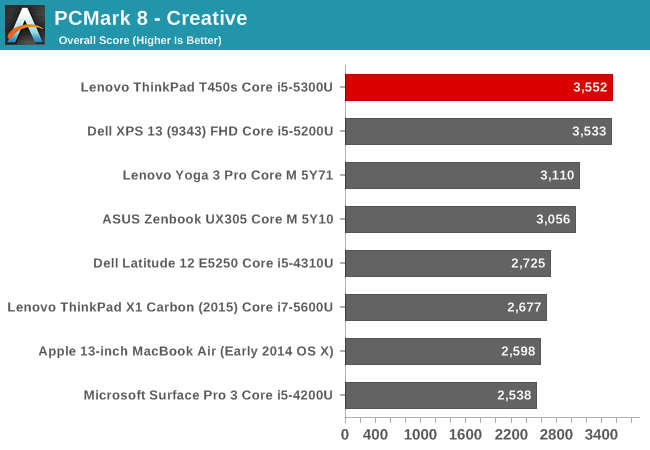
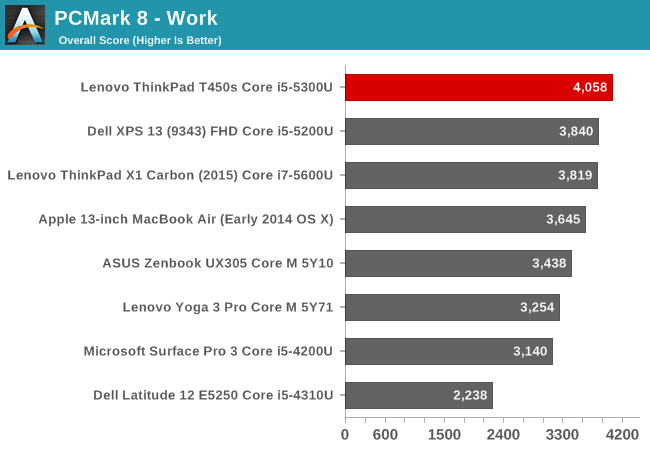
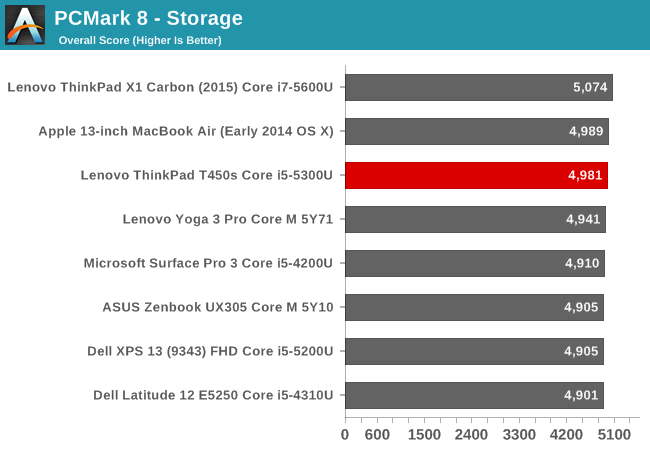
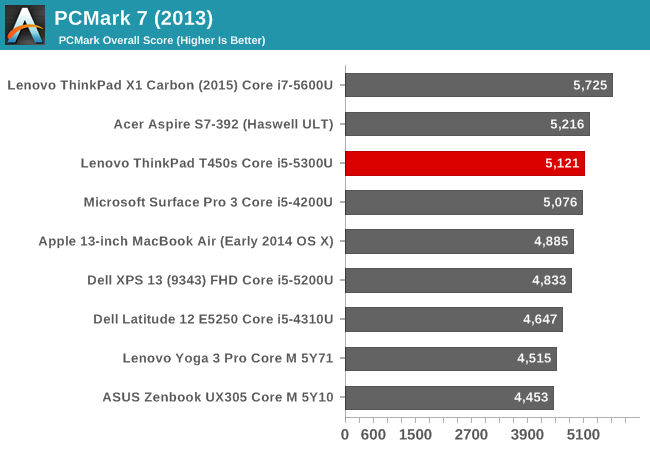
PCMark tries to replicate real world use scenarios with its various workloads. It will have sustained performance as well as burst performance requirements, and storage is also a factor in the scores. The ThinkPad T450s scores very well on these tests, outperforming other devices with Core i7 even. Since PCMark is a comprehensive test, even things like display resolution come into play so the 1920x1080 panel is a benefit to these scores since the GPU has an easier time. Storage is right in line with other SSD based devices. PCMark tends to group all SSDs pretty closely together because of the traces it uses to score the result.
CrystalDiskMark
To get a better feel for the absolute performance of the drive, CrystalDiskMark was run which provides the typical maximum speeds and this will show more of a difference in maximum speeds than PCMark will. That does not discredit PCMark though since it is trying to show real world performance, and maximum transfer speeds don’t come into play as often when you are doing office tasks. The T450s shows good performance, but for those that need to move very large files around, a notebook with PCIe storage is going to be a better choice. I don’t think that’s the target market for the T450s though the performance is adequate.
Cinebench
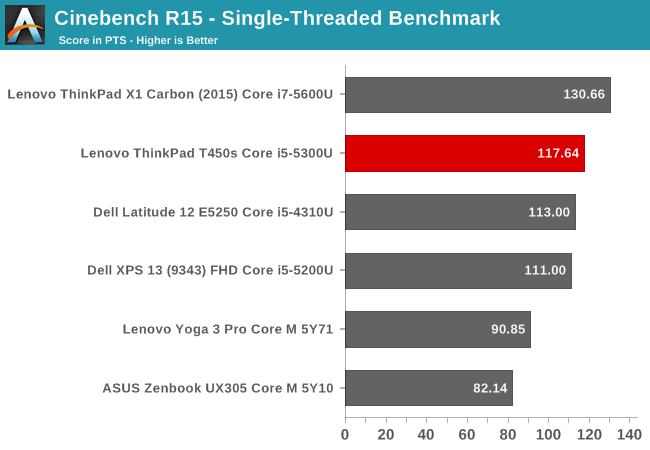
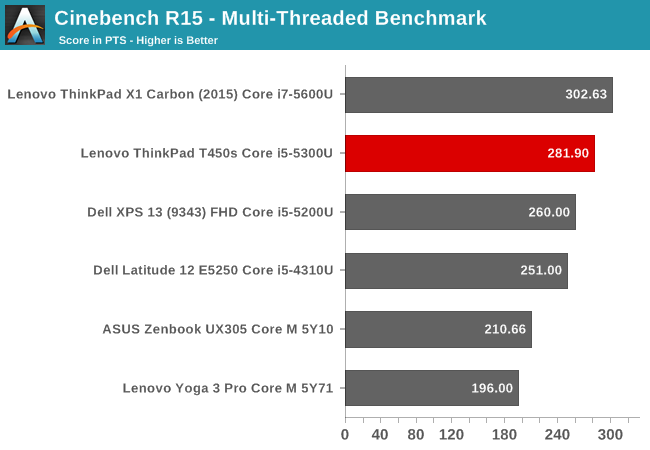
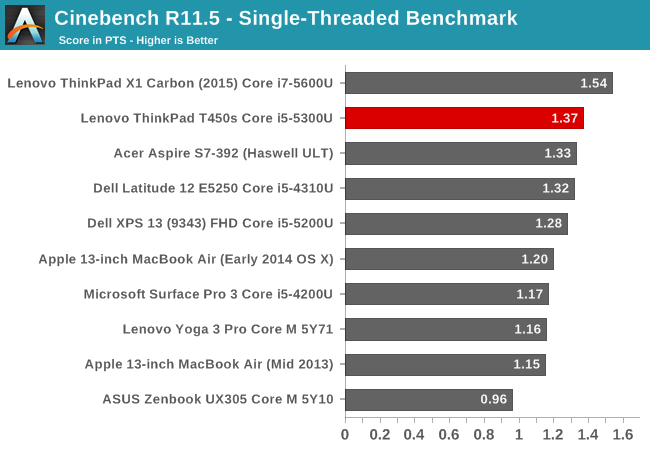
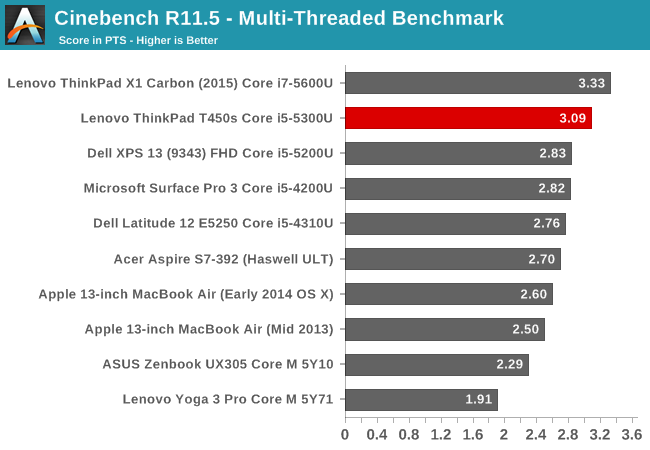
Cinebench is a mostly CPU benchmark. The Core i5-5300U is exactly where you would expect which is between the X1 Carbon with its Core i7-5600U and the Dell XPS 13’s Core i5-5200U.
x264
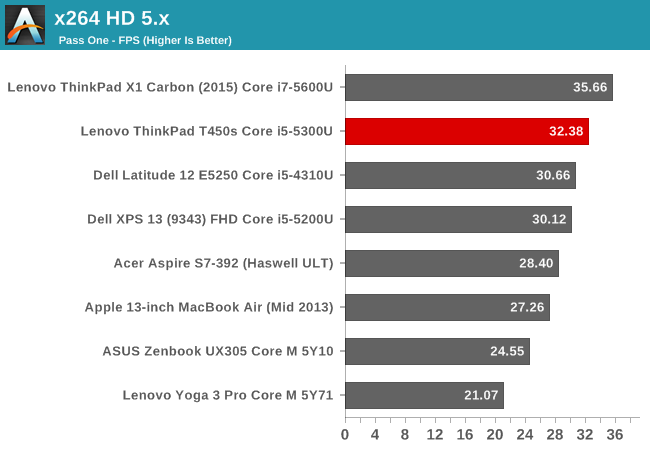
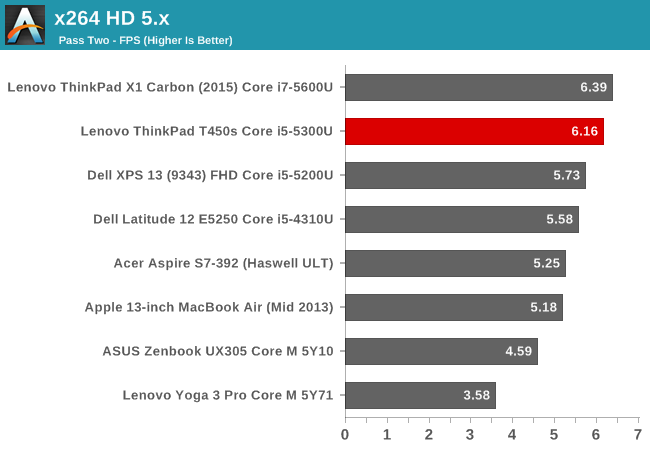
As with Cinebench, this mostly CPU based test shows the performance gain achieved with the mid-level Core i5 in this notebook.
Web Tests
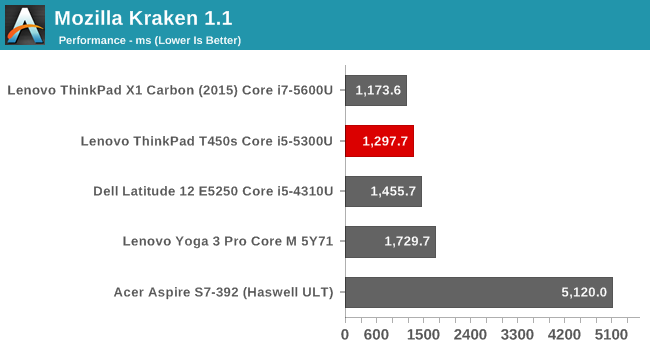
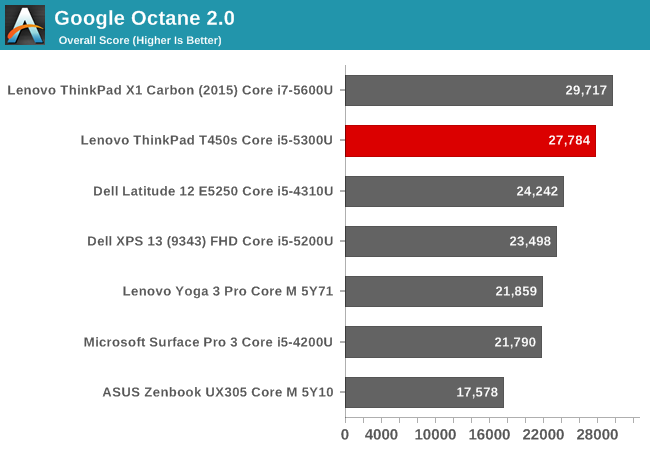
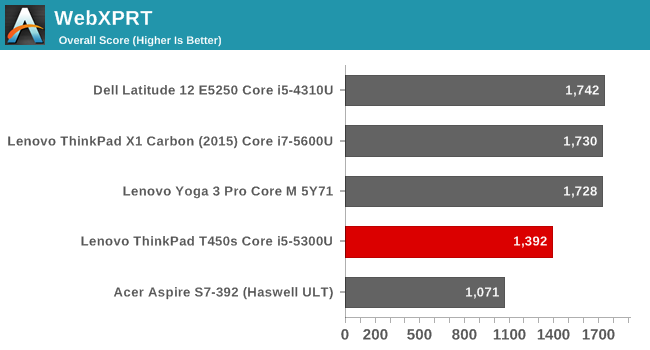
Web browsing continues to be an important metric. On this Windows 8.1 device, testing was done with the latest version of Chrome (version 45) but with Windows 10 now released, we’ll be switching to Edge since its performance is now comparable. The i5-5300U once again shows it is a decent upgrade over the base i5-5200U.
Overall System Performance
There is not a lot of surprises right now in the Ultrabook space. Broadwell-U based devices have been shipping since the beginning of the year and this notebook is still only available with Windows 8.1. Overall performance is very good for this class of device and the i5-5300U is a reasonable upgrade over the base offering. For those that need better performance, there is an i7-5600U model as well which should then score this laptop similar to the X1 Carbon in the above graphs. The choice of SSD is not the fastest around, but it still offers good sequential and random speeds, it just can’t compare to the latest PCIe based storage on something like the X1 Carbon.


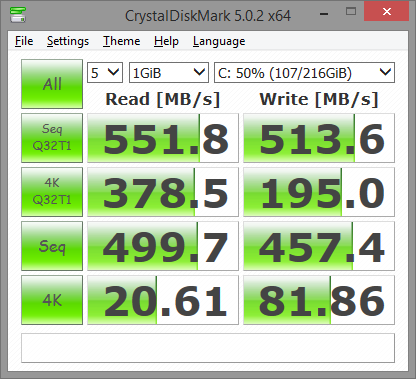








108 Comments
View All Comments
lilmoe - Tuesday, September 15, 2015 - link
Thanks for the review.Would be nice if you'd include the battery capacity of each device in the comparison chart.
lilmoe - Tuesday, September 15, 2015 - link
*All the devices* that is, not just the one being reviewed.Gigaplex - Tuesday, September 15, 2015 - link
"Durability is something that business wants too, since these devices are going to be used as long as they can be before replacement."Most businesses I've seen that get mobile workstations like this tend to operate on a 3 to 5 year cycle. Once the warranty expires, the machine is retired. It's generally home computers that limp along for as long as possible.
DanNeely - Tuesday, September 15, 2015 - link
Or shifted to 2ndary duty anyway. If you need a 2nd computer with something other than the standard configuration where I work; odds are you're going to get an older laptop that was lifecycled back to IT by its original user.jbwhite99 - Tuesday, September 15, 2015 - link
First off, warranty can be extended to up to 5 years - sometimes in the base, sometimes as a warranty upgrade.The PC is a small part of TCO (total cost of ownership); keep in mind all of the other pieces - licensing software (Office will cost you $250 per machine, etc), the customization you do when you get a new PC, transferring files over, etc. So for companies, if you keep your PC longer, you will save in the long run. The other thing you get with this is unsealed batteries - so if the battery conks out, you can replace it (not so sure about the built in battery). This is why I don't like sealed batteries - it makes the machines thinner, but you can't replace parts.
To the first page of the article, the T20 (first T-series, followon to the ThinkPad 600) came out in July of 2000. The first lettered ThinkPad was the A20, and it came out in April 2000.
nico_mach - Tuesday, September 15, 2015 - link
All the pictures have this curvature that I find distracting. Was that taken with a smartphone?Brett Howse - Tuesday, September 15, 2015 - link
All pictures were with a Canon DSLR.flashbacck - Tuesday, September 15, 2015 - link
How does the clickpad compare to the one in the t440?Brett Howse - Tuesday, September 15, 2015 - link
I've never used the T440 sorry.GeorgeH - Tuesday, September 15, 2015 - link
Any chance of sourcing the T450s with a dGPU for review? Curious what the American market is missing.